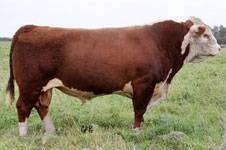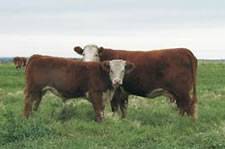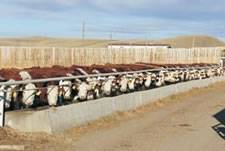Canadian Hereford Association
Herefords were first imported into Canada by William F. Stone of Guelph, Ontario from Herefordshire, England. He admired their strength, docility and feed efficiency. Herefords have prospered in Canada for over 150 years, due to these strengths and their hardiness in the coldest of winters and driest of summers.
Today, these major breed strengths of disposition and feed efficiency, along with its versatility in crossbreeding
programs, continue to position Hereford as the breed of choice in commercial cowherds. It is currently the second
most popular breed exported from Canada.
Herefords are leaders in docility. Research has proven that docile temperament increases cattle profitability through lowered production costs and better meat quality. Disposition is becoming increasingly important as a sought-after trait by producers purchasing either female or bull replacement for their cattle operations. Cattle with a good temperament are easier to handle, safer to be around at calving time, adjust better to new environments and tend to perform better in all phases of the production chain.
Herefords are widely used for cross breeding in North America, especially with Angus cattle. A recently completed
research study conducted in conjunction with California State University indicates an overall net return for Herefordsire crossbred calves to be approximately $30.00 (USD) per head in a vertically coordinated beef marketing system. US Meat Animal Research Center (MARC) research shows hybrid vigor to be greater in whiteface cross cattle, due to the genetic purity in the Hereford breed.
The Hereford breed is recognized as being more efficient. Hereford and Hereford influence cattle consistently require less feed than cattle of other breeds, per pound of gain and for body maintenance. Disposition and the thick hide and excellent hair coat of Hereford cattle are among the reasons less energy is required to stay warm in the winter, thereby reducing feeding costs. Again research has shown that Hereford cattle are about 6.0% more feed efficient than other breeds, which is a significant economic factor for profitability.
The Canadian Hereford Association was formed in 1890 and was incorporated in 1902 under the Government of Canada Animal Pedigree Act. The Animal Pedigree Act ensures the integrity of the registration and documentation of the ancestry of purebred Hereford cattle. The Canadian Hereford Association is also part of the Pan American Cattle Evaluation (PACE) program which includes genetic evaluations from the countries of Argentina, Uruguay and the USA. Semiannual genetic evaluation reports are produced by PACE members for their respective members. The Expected Progeny Differences (EPDs) are reported on 11 traits, which include calving ease, birth weight, weaning
weight, yearling weight, carcass traits, scrotal circumference, cow weights and stay-ability. The Canadian Hereford Association also independently produces a genetic evaluation index for maternal productivity and feedlot merit, in order to track, retain and improve on these traits.
The Hereford breed is among those which represent the foundation of Canada's beef industry, making it one of the most widely used cattle breeds. More Hereford genetics have been exported from Canada in the past 30 years than from any other breed. Live animals, semen and embryos have been exported to: the USA, Russia, Kazakshtan, Australia, New Zealand, the U.K., Ireland, all the Nordic countries, Germany, Japan, China, Hungary, Chile, Poland,
Brazil, Argentina, Uruguay, and South America.



